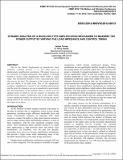Dynamic Analysis of a Buckling-Type Amplification Mechanism to Maximize the Power Output by Varying the Load Impedance and Control Timing
Author(s)
Torres, James; Asada, H. Harry; Asada, Haruhiko
Download123_1.pdf (1.044Mb)
PUBLISHER_POLICY
Publisher Policy
Article is made available in accordance with the publisher's policy and may be subject to US copyright law. Please refer to the publisher's site for terms of use.
Terms of use
Metadata
Show full item recordAbstract
Due to the limited displacement of piezoelectric stack actuators, common practice is to use some form of displacement amplification mechanism. This paper focuses on an externally leveraged mechanism that utilized a buckling motion to achieve large amplification ratios within a single stage. This mechanism interfaces with a sinusoidal gear track that acts as the load. The dynamics of the system are derived and are shown to be fifth order. Due to the significantly nonlinear amplification caused by the buckling phenomenon and the gear, the dynamics are run in simulation to gain insight into the performance of the actuator. There is shown to be an optimal speed at which to run the actuator to maximize the possible power output. Furthermore, due to the simple binary control significant benefits are achieved by varying the control timing based on the velocity to ensure the force and velocity of the output are in phase. Copyright © 2012 by ASME.
Date issued
2012-10Department
Massachusetts Institute of Technology. Department of Mechanical EngineeringJournal
Volume 2: Legged Locomotion; Mechatronic Systems; Mechatronics; Mechatronics for Aquatic Environments; MEMS Control; Model Predictive Control; Modeling and Model-Based Control of Advanced IC Engines;
Publisher
ASME International
Citation
Torres, James, and H. Harry Asada. “Dynamic Analysis of a Buckling-Type Amplification Mechanism to Maximize the Power Output by Varying the Load Impedance and Control Timing.” Volume 2: Legged Locomotion; Mechatronic Systems; Mechatronics; Mechatronics for Aquatic Environments; MEMS Control; Model Predictive Control; Modeling and Model-Based Control of Advanced IC Engines, 17-19 October, 2012, Fort Lauderdale, Florida, ASME, 2012, p. 123. © 2012 by ASME
Version: Final published version
ISBN
978-0-7918-4530-1